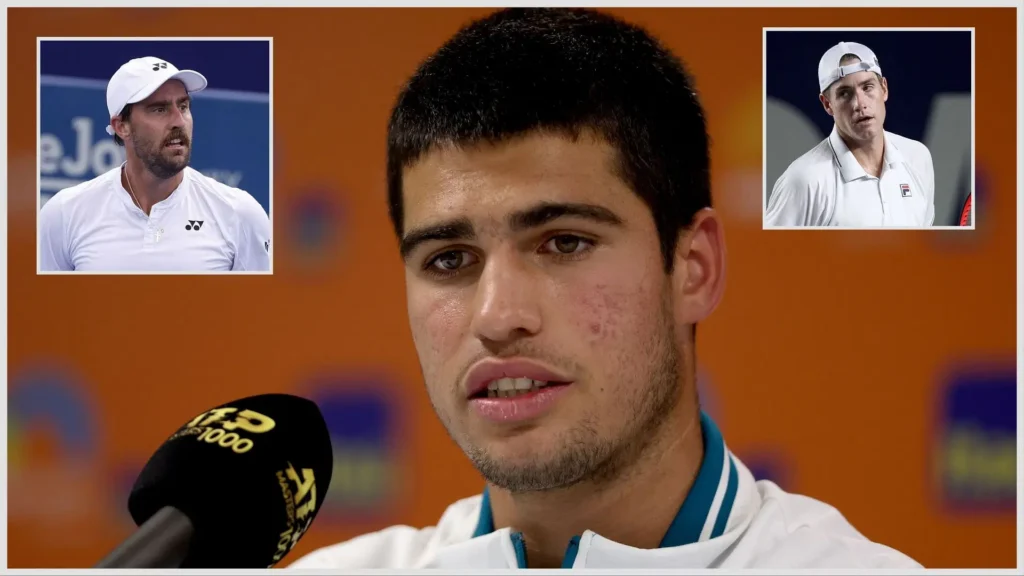
Carlos Alcaraz’s decision to forego the South American swing in favor of competing at the ATP 500 event in Rotterdam has sparked debate among tennis analysts and former players. Steve Johnson and John Isner, both experienced competitors on the ATP Tour, have weighed in on Alcaraz’s choice, questioning whether it stems from strategic planning or potential mental scar tissue left by previous struggles on clay courts in the region.
Alcaraz’s Decision: A Tactical Move or Fear of Past Failures?
At just 20 years old, Carlos Alcaraz has already established himself as one of the most formidable players in men’s tennis. His combination of power, speed, and tactical intelligence has seen him claim two Grand Slam titles and reach the pinnacle of the ATP rankings. However, despite his remarkable success, his decision to skip the traditional South American clay-court season has led to speculation about whether he is avoiding the psychological challenges associated with past performances on the surface.
Steve Johnson, a veteran of the ATP Tour known for his tactical acumen, has suggested that Alcaraz’s choice may indicate a lingering mental scar from previous disappointments. While Alcaraz has had strong results on clay, including a title in Rio de Janeiro and a deep run at Roland Garros, Johnson believes that setbacks in key matches might have influenced the young Spaniard’s scheduling decisions.
“It’s interesting that Alcaraz is opting out of the South American swing, especially given his prowess on clay,” Johnson stated. “It makes you wonder if he’s trying to avoid certain mental hurdles rather than just focusing on hard courts.”
John Isner’s Perspective: Prioritizing Hard Courts Over Clay
John Isner, one of the most accomplished servers in tennis history, took a slightly different approach to the debate. Isner pointed out that while Alcaraz is undoubtedly a strong clay-court player, his hard-court performances have elevated him to an elite level. Given that most of the high-profile tournaments, including the ATP Finals and major Masters 1000 events, are played on hard courts, Isner believes Alcaraz’s choice to prepare for Rotterdam makes sense from a long-term perspective.
“Carlos is a brilliant player on any surface, but if you look at the modern game, hard courts dominate the calendar,” Isner explained. “It’s not surprising that he wants to fine-tune his skills in Rotterdam rather than play on clay in South America. It’s about sustainability and preparing for the bigger tournaments.”
Alcaraz’s decision also aligns with the scheduling approach taken by other top players, such as Novak Djokovic and Daniil Medvedev, who have chosen to focus on hard-court events early in the season rather than expend energy on a different surface immediately after the Australian Open.
Is Mental Scar Tissue a Factor?
While Johnson’s comments suggest that Alcaraz may be carrying mental baggage from previous tournaments, others argue that the young Spaniard has shown remarkable mental toughness throughout his career. His ability to bounce back from tough losses and adapt to different playing conditions has been one of his defining traits.
Alcaraz himself has not publicly indicated that past defeats have played a role in his decision. Instead, his team has emphasized the importance of load management and surface transition planning. With the Miami Open and Indian Wells Masters coming up—two of the biggest hard-court tournaments outside of the Grand Slams—Alcaraz’s focus on Rotterdam could be a strategic move rather than a reaction to past struggles.
The Implications for Alcaraz’s Season
By choosing to play in Rotterdam, Alcaraz is setting himself up for a strong hard-court campaign. The indoor conditions in Rotterdam will allow him to sharpen his aggressive baseline game and work on his shot-making under faster conditions. Additionally, skipping the clay swing in South America could help him conserve energy and avoid unnecessary risk of injury ahead of the demanding North American hard-court season.
Despite this, some critics argue that avoiding a surface where he has previously excelled might hinder his preparation for the clay season, including events like Monte Carlo, Madrid, and Roland Garros. If Alcaraz hopes to claim another French Open title, time on clay courts could be crucial to fine-tuning his movement and endurance.
How This Affects the Competition
With Alcaraz absent, the South American clay-court tournaments will see a shift in the competitive landscape. Defending champions and clay-court specialists will have a greater opportunity to claim titles and gain valuable ATP points. Players such as Casper Ruud, Dominic Thiem, and Diego Schwartzman could capitalize on Alcaraz’s absence, strengthening their positions in the rankings while building momentum for the European clay season.
Meanwhile, Alcaraz’s presence in Rotterdam adds another layer of excitement to the tournament. The ATP 500 event traditionally attracts a strong field, and his participation will be a significant test against high-caliber opponents on indoor hard courts. If he performs well, it will further solidify his standing as an all-surface contender heading into the next phase of the season.
Conclusion: A Calculated Risk or a Necessary Adjustment?
Ultimately, Alcaraz’s decision to skip the South American swing in favor of Rotterdam is a strategic one. Whether or not it is influenced by past setbacks, as Johnson suggests, remains speculative. What is clear is that Alcaraz and his team are prioritizing long-term success over short-term gains. His ability to transition smoothly between surfaces and maintain peak performance will be key in determining whether this decision proves beneficial.
With the tennis season in full swing, all eyes will be on Alcaraz as he competes in Rotterdam, looking to justify his scheduling choice and continue his ascent in the ATP rankings. Whether or not mental scar tissue exists, one thing remains certain—Alcaraz is a player who continues to challenge the status quo, and his journey this season will be closely watched by fans and analysts alike.
Leave a Reply